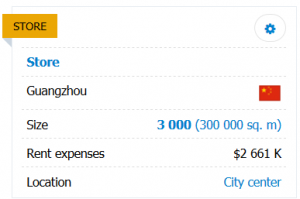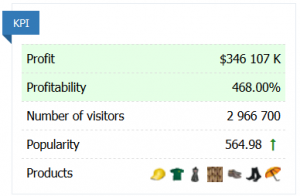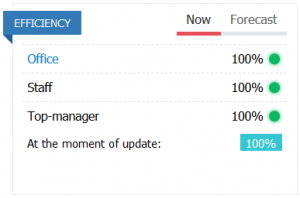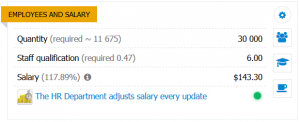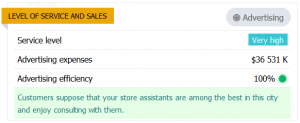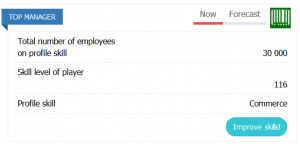Store/en: различия между версиями
DarkRyu (обсуждение | вклад) |
DarkRyu (обсуждение | вклад) |
||
| Строка 29: | Строка 29: | ||
| − | === | + | ===EFFICIENCY=== |
[[File:store_eff_en.png|thumb|Store efficiency]] | [[File:store_eff_en.png|thumb|Store efficiency]] | ||
'''Efficiency of the Office''' - the efficiency of the managing office of the region, where the store is located. | '''Efficiency of the Office''' - the efficiency of the managing office of the region, where the store is located. | ||
| Строка 38: | Строка 38: | ||
'''Efficiency''' - the efficiency of the store for the last turn. It is a function of 3 indicators of efficiency - staff, office and Top-manager. Efficiency is a key parameter that determines the success of a store. Low efficiency negatively affects sales, regardless of product mix and level of service. The low efficiency of the store means that not all visitors who wanted to make purchases were able to do this. With a decrease in work efficiency by 30%, sales can be halved. | '''Efficiency''' - the efficiency of the store for the last turn. It is a function of 3 indicators of efficiency - staff, office and Top-manager. Efficiency is a key parameter that determines the success of a store. Low efficiency negatively affects sales, regardless of product mix and level of service. The low efficiency of the store means that not all visitors who wanted to make purchases were able to do this. With a decrease in work efficiency by 30%, sales can be halved. | ||
| − | |||
===EMPLOYEES AND SALARY=== | ===EMPLOYEES AND SALARY=== | ||
Версия 11:17, 15 июня 2020
RU https://virtonomica.ru/help/index.php/Store/ru
Содержание
STORE
The size of the store largely determines the traffic of visitors. The larger the store, the greater the number of customers who enter the store simply “from the street” - this is the so-called basic traffic. In addition, the larger the store, the greater the influence of the store’s popularity on growth of traffic - at the same level of popularity, a store with a larger size will attract a relatively large number of visitors (as a percentage of basic traffic). Given that the basic traffic to a larger store is also higher, the absolute increase due to popularity will be quite significant.
However, this does not mean that every time you open a store it should be of maximum size. A large store is highly demanding in terms of staff qualification, top manager skills and volume of supplies. The ideal size of the store is sufficient to maintain a high level of service and store efficiency.
In addition, from the point of view of a buyer, the product offers in large stores are more passive. The smaller the store, the more visitors react to the appearance on the shelves of a truly good product. While in a large store, a visitor may simply not notice a profitable offer.
Location of the store, as well as its size, determines the basic traffic. Stores located in the City center have the maximum basic traffic. Next in descending order by traffic decrease: Residential area, Outskirts, Suburbs and Trendy neighborhood. The average level of wealth in a Residential area corresponds to the average level in a city. As you move from the center to the suburbs, the level of wealth gradually decreases. But in a Trendy neighborhood, the level of wealth can significantly exceed the average value of the city. Naturally, the number of buyers with such a high level of income is not very large.
In addition to traffic and the level of wealth, as well as the buyers’ preferences (determined by the level of wealth), the location of the store can be significant in markets with strong competition. Specifically, in saturated markets there is strong competition on city district level. Accordingly, if most of the stores are located in the city center, then they will suffer primarily from a high level of competition. While a lonely store on the outskirts will not be affected by those major trade wars.
KPI
The number of departments in the store is determined by the number of product categories in the Trade hall. The fewer departments, the better, as given other equal conditions, each specific product is sold. In addition, with higher number of departments, it is more difficult to maintain a high level of service. The total area of the store is divided equally into all departments. At the same time, it does not matter what is the reserve (in warehouse) of the goods presented in Trade hall and how well they sell. Therefore, it is recommended to timely clean up the Trade hall from "ballast", for which the operations - "Move products to the warehouse" and the group operation "Eliminate the remaining goods" are provided in the Trade hall.
The store’s popularity level determines the actual store traffic in relation to the basic traffic. The higher the popularity value, the more visitors come to the store on average. Popularity of the store can be increased through advertising. The number of visitors that come to the store, depends on its popularity and the size of the store - the larger the store, the more curious visitors it attracts for each unit of the popularity value.
The store’s sales volume primarily depends on the number of visitors. The number of visitors, in turn, depends on the degree of popularity of the store. When a new store is opened, its level of popularity is zero and only random visitors from the street enter it. You can increase the popularity of the store through advertising. An advertising campaign can cost quite a lot of money, but the effect of increasing sales can significantly cover costs. Sometimes it makes sense to conduct a large-scale advertising campaign immediately after the opening, as this will allow to ensure initial popularity of the store and quickly make it profitable.
The efficiency of an advertising campaign of the store depends on the amount of money spent, as well as on the type of advertising and its efficiency. The more money you invest into advertising, the more large-scale channels you can use to attract the attention of the buyers: from the Internet and outdoor advertising to radio and television. It is necessary to ensure that the visitors of the store are provided with the necessary level of service, that is, the size of the retail space and the number of personnel correspond to the tasks of the store.
Over time the effect of promotions decreases, and the amount required to maintain the store’s current popularity increases. To maintain a constant level of fame for the store requires almost constant promotions.
The number of customers who come to the store is one of the key characteristics that determine the sales volume and, accordingly, the success of trade. The more customers visit the store, the greater the sales. On the other hand, an excessive number of visitors can jeopardize the effectiveness of sellers and significantly reduce the level of service, which will not increase, but, on the contrary, reduce sales. The number of customers is determined by the number of residents in the city, the size of the store and its location. This is the so-called basic traffic. The final number of buyers is calculated relative to the basic traffic, taking into account the effect of advertising, as well as a random factor (± 20%).
EFFICIENCY
Efficiency of the Office - the efficiency of the managing office of the region, where the store is located.
The efficiency of the staff. The efficiency of the sellers determines how well the store staff copes with their duties and how well the visitors (who arrived) are served. The higher the number of store visitors and their wealth level, the more sellers are needed for their highly efficient work, and the higher their qualification should be (the richer the customer, the more finicky he is). The effectiveness of sellers affects the overall performance of the store and the level of service in the store.
The efficiency of a Top-manager - the efficiency of Top-manager. Depends on the correspondence of the top managers skill (Trade) to the qualifications of the staff in all similar (use Trade skill) subdivisions of the company as a whole.
Efficiency - the efficiency of the store for the last turn. It is a function of 3 indicators of efficiency - staff, office and Top-manager. Efficiency is a key parameter that determines the success of a store. Low efficiency negatively affects sales, regardless of product mix and level of service. The low efficiency of the store means that not all visitors who wanted to make purchases were able to do this. With a decrease in work efficiency by 30%, sales can be halved.
EMPLOYEES AND SALARY
Quantity of employees - the current number of employees in the store. Determines the level of service. Additionally, the size of inventories affects the required number of employees. When the warehouse is overcrowded, the required number of employees increases, which can affect the drop in the level of service.
Salary of one employee - weekly salary of one employee. The average salary of employees of this type of unit in the city is indicated in brackets (each type of business unit has its own coefficient).
Staff qualification - the current qualification level of employees (in addition, the average city qualification value and the required value determined by the quality of goods are indicated in brackets).
LEVEL OF SERVICE AND SALES
Level of service is an important characteristic of the store, which determines the quality of customer service. Ultimately, the higher the level of customer solvency, the more level of service affects sales. For wealthy customers (for example, from Trendy neighborhood), the level of service can be very important, more important than the price of goods. The level of service consists of two components: the sufficiency of retail space and the coordinated work of sellers. And, of course, it primarily depends on the number of visitors, since five people can easily fit in an area of 20 square meters, but 500 can hardly be accommodated. Lack of space, insufficient number of sellers and / or insufficient qualifications of sellers are the main reasons for the decline in the level of service. Since the total area of the store and sellers are evenly distributed across each product group, the level of service directly depends on the number of departments in the store.
Service includes a certain proportion of attention given to each buyer by sellers. The more visitors, the fewer sellers - the less attention each seller can give to customers. The store staff is also characterized by the level of qualification: the higher the qualification, the higher the level of service. Often, a small number of highly qualified sellers can serve visitors better than an army of low-skilled sellers.
However, one should not forget: if, in the pursuit of high service, the store owner will hire too many sellers and / or the sellers will be too qualified, then due to the insufficient skill “Commerce” of the store management of Top-manager, the overall efficiency of the store may drop sharply.
Another important detail: it is very difficult for huge developed supermarkets in large cities to provide an elite level of service. Therefore, a powerful advertising campaign will lead to an influx of visitors, and that will cause a catastrophic collapse in the level of service, as a result bringing the store more harm than good.
When evaluating the level of service, it is useful to pay attention to the staff efficiency. These characteristics perfectly complement each other. However, it should be remembered that when assessing effectiveness, the area factor and the number of product sections are not taken into account.
TOP MANAGER
Total number of employees on profile skill is the total number of employees of all enterprises in this field in the company. It affects the effectiveness of the top manager.
Skill level of player - current “Commerce” skill level of the Top-manager. Determines maximum manageable number and qualification of personnel without loss of efficiency both in this particular unit and in all enterprises of the company as a whole (an additional hint about the reserve of the current level compared to the minimum requirements can be indicated in brackets, minimum - 0-25%, normal - 25-50%, good 50-100%, excellent more than 100%).
TRADE HALL
Trade hall reflects the current state of affairs in your store. It shows all the goods presented on the shelves of your store, as well as ordered goods and those which sale has already been discontinued. For each good, column “Sales volume” indicates sales for the last week (turn), and the link below this value leads to statistics on sales of goods for the last 52 weeks (indicating the quantity of goods, quality, brand and selling price for each week).
The following columns contain information about the current supply of the store with this type of product. “Purchase volume” - current order / actual purchase for the last week (in brackets). Information about the current stock of products - “In stock”, “Quality”, “Brand” and “Purchasing price” of products. “Market share” of your store of a specific product in the whole city, and the average city statistics for the same good (including both Local suppliers and all existing player stores).
To start sales in the store, you must have goods on the shelves of the Trading Hall and be sure to set the price and type of sale on it. By default, the type of sale is set to "Regular sale", in which the store operates in standard mode and sells goods in accordance with the prices set by the manager (you). Please note that if you do not set a price (leave 0.00), it will be equivalent to setting the type "Do not sell" and there will be no sales of the specified product. In the "Sale" mode, the system automatically selects a price based on conditions to maximize sales. At the same time, price is not influenced by the cost of the goods or on the price set by the manager (you). At the same time, under the price-setting window, the inscription “sale” appears and in the window itself the price, at which the goods were sold in the last turn, is displayed.
Under the window to choose the type of sale, there is a form for simplified choice of supplier of goods and a block of special operations to eliminate the remaining goods. If you want to close the department, then you need to check the boxes next to ALL products from the department and click "Eliminate remaining goods". Moreover, all inventories will be completely eliminated without any compensation. However, be careful: this function does not interrupt orders for these types of goods, so if you do not stop the supply orders for these items, the department may reappear when purchasing at least one unit of any product from the category of the department.
SUPPLY
Supply tab displays all contracts for the purchase of products in your store. You have the opportunity to adjust existing contracts:
- change the number of products purchased,
- set limits on contract for cancellation if - there is a certain relative or absolute change in price or there is a decrease in the quality of delivered goods below a certain threshold),
- and enter new contracts for the supply of any product present in the game.
Above the list of contracts, the preliminary value of order is calculated at current prices (at the declared quantity and at affordable prices), as well as the sum spent for purchase for the previous turn. This will allow you to plan the company's budget for the current turn.
